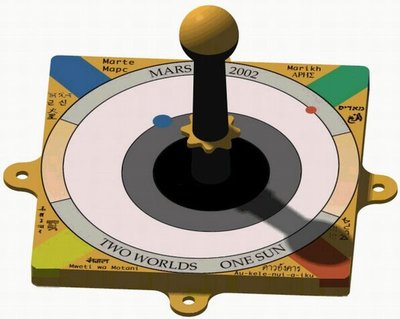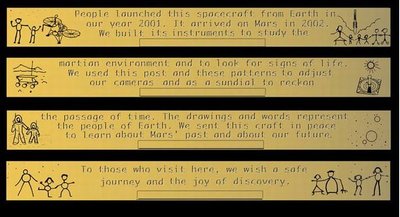April 21, 1999
Sundial will mark passage of days, seasons on Mars
You could call it Martian Standard Time. The new “time zone” takes effect in January 2002 when a sundial designed and assembled at the University of Washington lands on the red planet aboard NASA’s 2001 Mars Surveyor.
The sundial project was announced today during a news conference at Cornell University in Ithaca, N.Y., which is creating the experiment that will contain the sundial. Once the sundial is in place, the public will be able to monitor the passage of Martian days and seasons via the Internet.
The idea for the sundial originated with Bill Nye, host of public television’s “Bill Nye the Science Guy.” It will be contained in a package of four instruments that make up the Athena Precursor Experiment, or APEX, on the Mars Surveyor mission scheduled for launch in 2001.
Nye, a Cornell graduate, noticed a small square and post used as a kind of test pattern to calibrate the spacecraft’s color panoramic camera, and suggested it could be a sundial.
“He sent an e-mail asking me if I wanted to help design the first sundial on Mars,” recalls UW astronomy professor Woodruff Sullivan, “and I sent one back asking, ‘Does it rain in Seattle?'”
Sullivan and Nye for eight months have been part of a design team that includes artists Jon Lomberg and Tyler Nordgren, Cornell planetary scientists Steven Squyres and Jim Bell, and Louis Friedman, executive director of the Planetary Society.
With the team’s design, Larry Stark, who makes scientific instruments in the UW physics department, devised detailed drawings for making the sundial. Much of the fabrication is being done at Arizona State University in Tempe. The parts will be returned to the UW for final assembly, and the sundial is to be delivered to NASA’s Jet Propulsion Laboratory in Pasadena, Calif., late this summer.
Sullivan, a sundial expert, has designed numerous instruments for reckoning time using the sun’s shadow, including a large one on an outside wall of the Physics-Astronomy Building on the UW’s Seattle campus. Designs must account for the Earth’s orbit and the site latitude if the shadow cast by the post is to give accurate time.
For the first sundial away from Earth, some factors differ. For one thing, a year is nearly twice as long on Mars. In addition, while Mars has seasons as Earth does, the seasonality is exaggerated because the planet’s orbit is far more elliptical. But there are similarities, too. Earth tilts about 23.5 degrees on its axis, while Mars tilts 25 degrees, and a Martian day is only 37 minutes longer.
“It’s not as different as you might think,” Sullivan said. “It’s the same basic principle, you just have to feed in different parameters. It’s like the difference between making a map of Los Angeles and a map of London.”
The Martian sundial will be located near the planet’s equator, though a final landing site for the Surveyor mission hasn’t been chosen. Uncertainty about the location, and the fact that the sundial could be tilted by surrounding terrain, limits the features that can be designed into it, Sullivan said. Once the spacecraft has landed, the panoramic camera will monitor the sundial’s shadow, allowing Sullivan and other scientists to calculate its exact orientation. The appropriate sundial lines then will be superimposed over the sundial’s image on the World Wide Web.
The sundial, made from anodized aluminum, is just 3 inches square and weighs slightly more than 2 ounces. Black, gray and white rings in the center and color tiles in the corners will be used to adjust the brightness and tint of pictures taken by the panoramic camera. The rings are arranged to represent the orbits of Mars and Earth, with red and blue dots showing the planets’ positions at the time of landing. Two replicas are being made, one as an engineering model and the other to be placed in the Smithsonian Institution.
The Athena Precursor Experiment is being developed under the leadership of Squyres, a Cornell astronomy professor.
The sundial will include a greeting for any explorers who might one day encounter it. The instrument also will have the word “Mars” in 24 Earth languages, including those of the ancient Mayan and Sumerian cultures in which Mars figured prominently, and stick figures and space-related drawings that depict Earthlings.
###
For more information, contact Sullivan at (206) 543-7773 or woody@astro.washington.edu
These web sites contain additional information:
http://www.athena.cornell.edu
http://emma.la.asu.edu/neweducation.html (Arizona K-12 Mars Education Program)


